|
 Secure Site
Secure Site
|
 |
 listening to music can reduce stress A number of studies show that listening to music, especially classical or baroque, may help you unwind and improve your mood.
Though less melodic, therapeutic CDs of “binaural beats” also show promise as a means of calming the mind and body, according to several studies. These recordings work by projecting two tones of similar frequencies into each ear. This creates a “beat” at a certain frequency in the mind, say proponents, and your brain falls in sync with it; different frequencies call forth different moods.
adapted from Body + Soul Magazine, 2010
 Bamboo Natural Chime Sound Alarm Clock  Now & Zen - The Acoustic Chime Alarm Clock Company - Boulder, CO Now & Zen’s Acoustic Chime Alarm Clock Store
1638 Pearl Street
Boulder, CO 80302
(800) 779-6383
Posted in Well-being
Stillness at Start and End of Day
 The best stress remedy is to do nothing, use a chime timer for a gentle reminder If checking your email has become as vital to your wake-up and bedtime routines as brushing your teeth, it’s time to unplug.
“Starting and ending the day in stillness is essential to stress reduction, so it’s absolutely critical not to jump into email during either of those times,” say”
In the morning and at night, turn off your computer (and TV) and pick up a book — or simply delight in the rare pleasure of doing nothing suggests Joan Borysenko, Ph.D., author of “Your Soul’s Compass.
A little nature therapy can also ease the stress of too much computer time. A stroll through a park or on a trail counteracts overstimulation and can also boost your mood and energy.
Our Digital Chime Zen Clock & Timer’s long-resonating Tibetan bell-like chime makes waking up and meditating a beautiful experience – its progressive chimes begin your day with grace.
adapted from Body + Soul Magazine, 2010
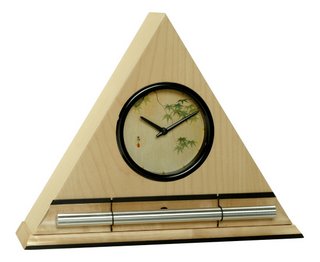 Zen Alarm Clock in Maple Finish, Japanese Leaves Dial Face and Stillness
Now & Zen’s Chime Timer Store
1638 Pearl Street
Boulder, CO 80302
(800) 779-6383
Posted in Chime Alarm Clocks, intention, mindfulness practice
 yogi tea Yogi tea is a hall-of-famer because it’s a timeless classic. The ayurvedic yogi tea (also known as chai) contains aromatic spices to warm and stimulate digestive fire while nourishing body and soul.
1 quart spring or filtered water
1 teaspoon whole black peppercorns
2 teaspoons cardamom seeds (or 3/4 teaspoon ground cardamom)
3-inch cinnamon stick, broken
1/4 teaspoon ground cloves
1-inch piece fresh ginger (or 1 teaspoon ground ginger)
1 teaspoon black tea leaves (may substitute decaffeinated black tea)
1/4 cup nonfat milk, or to taste (may substitute soymilk)
2 tablespoons honey, or to taste (optional)
1. In a medium saucepan, bring the water to a boil over high heat. Set your Zen Timer with Chime for 30 minutes. Add the spices, reduce heat, and simmer for 30 minutes.
2. Set your Zen Timer with Chime for 10 minutes. Add the tea leaves and let steep for 10 minutes. Strain the tea and add milk and honey, if using.
240 calories, 3g fat, 70g carbohydrates, 3.5g protein
adapted from Natural Home Magazine, Nov./Dec. 2005 by Elaine Gavalas
 Bamboo Zen Clocks and Chime Timers, a Natural Sound Timer for Tea Now & Zen’s Alarm Clock and Meditation Timer Shop
1638 Pearl Street
Boulder, CO 80302
(800) 779-6383
Posted in Chime Alarm Clocks, mindfulness practice, Well-being, Zen Timers
 breathing exercises help relieve stress How simple breath work can lead you to a deep state of relaxation.
Beginning students often ask for instructions on the “right” way to breathe. Alas, there’s no single answer to that question, since the optimal breathing pattern at any given moment depends on the type of practice. Restorative yoga focuses solely on relaxation, though, and emphasizes breathing that creates calm and serene states of being. When you settle into restorative poses, try the following techniques for cultivating breathing patterns that are hallmarks of relaxation and well-being.
MOVE THE BELLY WITH THE BREATH. When we are at ease, the diaphragm is the primary engine of the breath. As we inhale, this domelike muscle descends toward the abdomen, displacing the abdominal muscles and gently swelling the belly. As we exhale, the diaphragm releases back toward the heart, enabling the belly to release toward the spine.
KEEP THE UPPER BODY QUIET. During high-stress times, it’s common to heave the upper chest and grip the muscles in the shoulders and throat. When we’re at rest, the muscles of the upper chest remain soft and relaxed as we breathe, and the real work occurs in the lower rib cage. To promote this type of breathing pattern, consciously relax the jaw, throat, neck, and shoulders, and envision the breath sweeping into the deepest parts of the lungs as you breathe in and out.
BREATHE EASY. Although some breaths may be deeper or faster than others, when we’re relaxed, the alternating rhythm of the inhalations and exhalations feels like a lullaby—smooth, soft, and uninterrupted by jerks and jags. Consciously relaxing into this wavelike, oceanic quality of the breath deepens our sense of peace and ease.
LENGTHEN THE EXHALATIONS. When we feel stressed, our exhalations tend to grow short and choppy. When we’re relaxed, though, the exhalations extend so completely that they are often longer than the inhalations. Some teachers even instruct that if we’re deeply relaxed, each exhalation will be twice as long as the inhalation. To facilitate this, try gently extending each exhalation by one or two seconds. Set your Bamboo Meditation Timer with Chime for 20 minutes and continue this exercise.
PAUSE AFTER EACH EXHALATION. In our most relaxed state, the end of each exhalation is punctuated by a short pause. Lingering in this sweet spot can be deeply satisfying and can evoke feelings of profound quiet and stillness.
LET THE WHOLE BODY BREATHE. When we are at ease, the whole body participates in the breathing process. Imagine a sleeping baby: When he breathes in and out, the belly swells and releases, the hips rock to and fro, the shoulders bob, and the spine gently undulates. This offers a mini-massage for the muscles and organs of the whole body, and turns each breath into a soothing melody that further calms and quiets every cell within.
adapted from Yoga Journal Magazine, by Claudia Cummins
Our Chime Meditation Clock & Timer’s long-resonating Tibetan bell-like chime makes waking up and meditation a beautiful experience – its progressive chimes begin your day with grace.
The Chime Meditation Clock & Timer serves as a countdown and interval timer for yoga, meditation, bodywork, etc.; and it can also be set to chime on the hour as a tool for “mindfulness.”
 Bamboo Meditation Timers with Soothing Chimes for Breathe Work Now & Zen’s Chime Timer and Alarm Clock Shop
1638 Pearl Street
Boulder, CO
(800) 779-6383
Posted in Meditation Timers, Meditation Tools, mindfulness practice, Well-being, yoga, Yoga Timer, Yoga Timers by Now & Zen, Zen Timers
 yoga sitting exercise Life is stressful, and it’s not unusual to feel fearful or anxious on occasion. A common symptom is the sense that you are “not in your own skin.” This feeling is caused by your energy, or qi, rising up and out of your body, according to Traditional Chinese Medicine (TCM). In TCM, fear is believed to spring from the kidneys, and anxiety is thought to be a sign of disharmony between the kidneys and the heart. Dantians are the body’s three reservoirs of energy, located between the eyes, the middle of the chest, and below the navel. This simple centering practice creates harmony between the middle and lower dantians, which can keep you calm in times of stress.
This exercise is designed to ground your energy, bringing you back to earth by reconnecting you with your breath and your center, says Shoshanna Katzman, L.Ac., author of “Qigong for Staying Young.” Keep your eyes open throughout the exercise, so you are fully present in your body.
1. Choose a comfortable place to sit, preferably away from other people. Sit up straight and keep feet flat on the floor. Imagine, and feel, your feet being rooted and connected to the earth.
2. Place your hand on your chest (at your middle dantian — one of your body’s three reservoirs of energy, located between the eyes, the middle of the chest, and below the navel) to nourish the energy of the heart, which “houses the mind.” Place your other hand on your belly just below your navel (at your lower dantian) to nourish the energy of the kidneys.
3. Begin taking slow, deep breaths; concentrate on your body expanding and contracting. Visualize your energy sinking lower and lower into your body. Breathing into the lower dantian strengthens kidney energy and helps release fear and anxiety. In doing so, you create more stability, becoming more centered and secure within yourself. Set your Zen Chime Timer for three minutes. Continue this breathing exercise for one to three minutes.
adapted from Body + Soul, July/August 2005
 Zen Chime Timer & Alarm Clock - Digital Version The Zen Chime Timer & Clock can serve as a countdown and interval timer for yoga, meditation, bodywork, etc.; and it can also be set to chime on the hour as a tool for “mindfulness.”
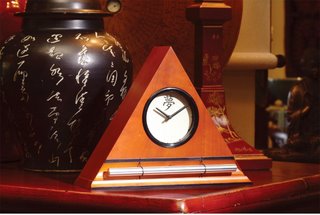 Chime Sound Clock, an Alarm Clock and Timer for Breathing Exercises with Soothing Sounds Now & Zen’s Clock Store
1638 Pearl Street
Boulder, CO 80302
Posted in Chime Alarm Clocks, Zen Timers
 A Stillness Practice for before Bedtime Tailgaters. Telemarketers. Teenagers. When you can sum up your day that way, it’s easy to respond with a few choice words of your own. Yet losing your cool rarely feels good or reflects your best character. To maintain your center and stay true to yourself, try this technique from David Simon, M.D., medical director and co-founder of the Chopra Center for Well-Being in Carlsbad, Calif.
Every night before bed, take a few minutes to mentally replay your day. This simple process gives you a different perspective on your actions, along with the opportunity to right any wrongs.
* Set your Zen Timer with Chime for 5 to 10 minutes. Sit up in bed with a pillow propped behind you; bend your knees or cross your legs comfortably on the bed.
* Close your eyes and take a few slow, deep breaths. Observing the in-and-out flow of your breath, allow your body to relax and your mind to quiet.
* Let the day’s events unfold. Picture each one from the time you awoke to the present.
* Notice if your body reacts negatively during any part of the process. A churning in your gut or a nervous response may signal something unresolved.
* Reflect on this particular event and ask yourself if you acted correctly. If anything feels unsettled, note it in a journal with the intention of addressing it the next day.
Revisiting unresolved issues offers you a second chance to do the right thing, Simon says. Maybe a disparaging remark was said about someone you like and respect, but you didn’t speak up at the time. Now you can tell the person who made the remark why such talk makes you uncomfortable.
Over time, annoyances like traffic jams will seem less significant and stressful. “You’ll be able to stay centered and balanced as you encounter the ups and downs of life,” Simon observes. Even better, this nightly evaluation will make you more aware of your goals and how they relate to day-to-day activities. “It will help you honor the person you want to be in the world,” he says.
adapted from Natural Health Magazine by Sarah D. Smith
The Zen Timer & Alarm Clock with Chime serves as a countdown and interval timer for yoga, meditation, bodywork, etc.; and it can also be set to chime on the hour as a tool for “mindfulness.”
 Natural Wood Chime Zen Timers and Alarm Clocks Now & Zen’s Chime Alarm Clock Shop
1638 Pearl Street
Boulder, CO 80302
(800) 779-6386
Posted in intention, Meditation Timers, Meditation Tools, mindfulness practice, sleep, Well-being, Zen Timers
 foot massage The senses can offer a shortcut to rest.
Massage comes to mind. So does aromatherapy; lavender essence in particular, small studies have shown, has a relaxing effect, even reducing stress hormone levels. Visual cues can raise or ease tension, depending on what you’re looking at. It’s a principle of design, for example, that horizontal lines are restful while vertical ones stir up power and tension (think a bed versus prison bars), and cool colors (blue, green) are said to induce more serenity than hot ones (red or orange). Views of nature have helped hospital patients heal faster. Gazing at an aquarium has been shown to slow the pulse.
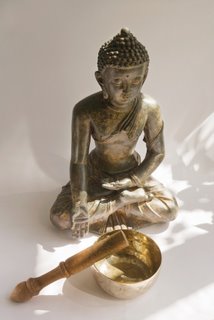 Carved Wooden Thai Buddha with Singing Bowl Sound, too, can be a potent relaxant, and tempo is a key player. Using various genres from classical to techno and rap, researchers found that, regardless of what music the subjects liked to listen to, an adagio (such as that from Beethoven’s Ninth Symphony) and an Indian raga physically decelerated the body into a calm state, compared with faster pieces like a Vivaldi presto (L’Estate) or a song by the Red Hot Chili Peppers. One reason for this may be respiratory entrainment, the tendency of the listener’s breath to rise and fall with the music’s beat. But another theory explains that putting on music—of any kind—can recharge you: When the tempo is brisk, it arouses our engagement; then when it slows or pauses, there’s a release of attention that leads to relaxation.
Lhasha Tizer, a wellness coach who teaches sound meditation at the Miraval Resort in Catalina, Arizona, believes that listening to nature’s sounds, a kind of music in itself, may have been the way our earliest ancestors meditated away stress. “Those rhythms create a trancelike state,” she says. (In fact, researchers at the University of Louisville School of Medicine found that a CD of natural sounds—birdsong, ocean surf—markedly shortened the amount of time it took people to physiologically recover from a stressful stimulus when compared with white noise.) “Today, with the way we work and the cacophonic noise we’re exposed to, we don’t have such an automatic gateway to help us focus and settle down,” Tizer points out.
To re-create that trancelike feeling through music, she suggests building up a sound repertoire. Start by being receptive to the sounds around you. Notice how noises affect you—children playing, horns honking, wind blowing through the trees. Gradually begin seeking out simple music with a clear percussive element. Pay attention to the beats you like, identifying the moods they evoke, and use those to guide you in choosing increasingly advanced melodies that carry away your anxiety.
In time, you’ll not only have a database of meditative music but, within it, be able to match your playlist to the mood you want to be in. Ultimately, a good rhythmic rest—and for that matter, any brief escape from a world where you always have to do to a place where you can just be—should make you feel like getting up and dancing.
Our Zen Timepiece’s acoustic 6-inch brass bowl-gong clock is the world’s ultimate alarm clock, practice timer, and “mindfulness bell.” It has the most beautiful natural Singing Bowl Sounds. It is not only an Alarm Clock by a Countdown timer for meditation and yoga.
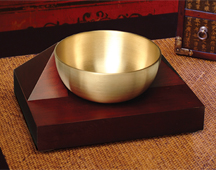 The Natural Sounds Singing Bowl Alarm Clock from Now & Zen, Inc.
It fills your environment with beautifully complex tones whenever it strikes. In the morning, its exquisite sounds summon your consciousness into awakening with a series of subtle gongs that provide an elegant beginning to your day. Once you experience the Zen Timepiece’s progressive awakening, you’ll never want to wake up any other way. It also serves as the perfect meditation timer. Available in 5 wood styles, including bamboo.
By Sara Reistad-Long
O, The Oprah Magazine
Now & Zen’s Natural Sounds Alarm Clock Shop
1638 Pearl Street
Boulder, CO 80302
(800) 779-6383
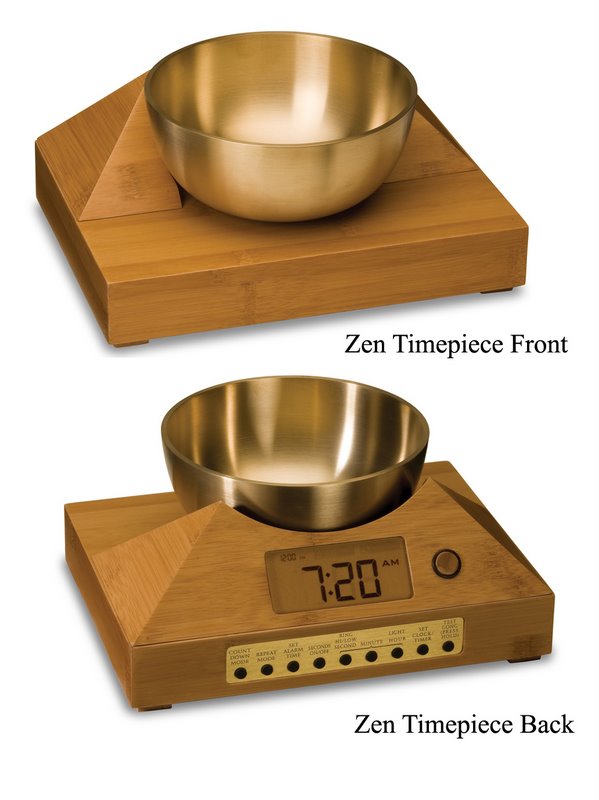 Sound Therapy Alarm Clock with Tibetan Singing Bowl
Posted in Natural Awakening, sleep, Sleep Habits
 Isoda Koryusai, Japanese (active c. 1764–1788) Change Your Alarm Clock…
The Digital Zen Clock’s long-resonating Tibetan bell-like chime makes waking up a beautiful experience – its progressive chimes begin your day with grace. When the clock’s alarm is triggered, the acoustic chime bar is struck just once … 3-1/2 minutes later it strikes again … chime strikes become more frequent over 10 minutes … eventually striking every 5 seconds until shut off. As they become more frequent, the gentle chimes will always wake you up – your body really doesn’t need to be awakened harshly, with a Zen Clock you’re awakened more gradually and thus more naturally. Unlike artificial recorded sounds coming out of a tiny speaker in a plastic box, natural acoustic sounds transform your bedroom or office environment.
The Digital Zen Clock also serves as a countdown and interval timer for yoga, meditation, bodywork, etc.; and it can also be set to chime on the hour as a tool for “mindfulness.”
Digital Zen Clocks feature a “high” and “low” chime strike volume control, which allows you to adjust the sound of the chime to suit your needs. The Digital Zen Clock runs on 2 AA batteries (not included) and can also be plugged in with the included AC jack. The clock includes a lighted digital display (which can be set to be lit full-time when plugged in).
 change your alarm clock so you eliminate the shock in your life Now & Zen’s Clock Store
1638 Pearl Street
Boulder, CO 80302
(800) 779-6383
Posted in Bamboo Chime Clocks, Natural Awakening, Now & Zen Alarm Clocks, sleep, Sleep Habits
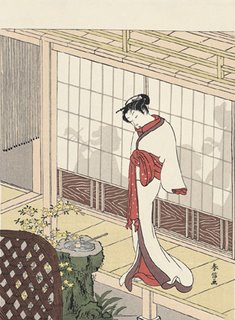 harunobu suzuki, Beauty at the Veranda
For most women who chronically bump along on near empty, it’s no mystery that getting to bed a little earlier would help. “The sleep system really does work like a bank,” says William Dement, MD, PhD, who—as chief of the sleep medicine division at the Stanford University School of Medicine—should know. “We can keep going for a long time on borrowed energy because our survival mechanisms kick in. At some point, however, every hour lost needs to be paid back.” But instead of the pillow, we’ll often reach for coffee—37 percent of American women chug more than three caffeinated beverages a day, according to the National Sleep Foundation—or a glass of wine, or something sweet, or the remote control to “wind down” with Anderson Cooper, who’s inevitably reporting from a war zone with things blowing up in the background. None of these efforts restores energy—some, in fact, do the opposite. Even when you do finally climb into bed, there are times when anxiety invades your sleep, leaving you bleary-eyed and dragging day after day. So we decided to investigate what—short of permanent residency at a spa—gives you a real rest.
Paradoxically, according to the newest research, when you’re looking for a profound rest cure, rather than trying to tune out, you may be better off tuning in and anchoring your awareness in the present moment. You can approach such engagement through various routes, like fully using your senses, practicing mindfulness, getting into a flow state, and—most difficult for many, but perhaps most effective—giving up the need to be in control.
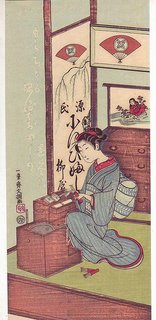 tune in Loch Kelly, A New York Buddhist-trained psychotherapist and meditation teacher, uses a technique called “resting in the heart space” to help people relinquish the reins; in his experience it provides the deepest rest in the shortest amount of time. “Traditionally, meditation focuses on getting to a state so neutral that there isn’t a problem to solve. Some monks spend 20 years in isolation working on just that.” But anyone, Kelly claims, can attain a sense of flow—and many of us already do through ordinary activities like gardening, knitting, working, or driving. When you’re in a car, for example, you have to focus on the road as it looks in the moment and, at the same time, stay alert to continually anticipate the next move. Eventually, your brain resolves the two directions it’s working in by falling into a rhythm, which leads to an open state of awareness that Kelly calls flow. You’re most likely to feel it after an unfettered drive in the country—no urgent sense of time passing or future demands impinging, but rather a merging into the current, a harmony with the environment as the present unfolds. “There’s something that’s unhooked from the mind, prior to thought, and at the same time intelligent,” Kelly says. “You can respond quickly.” Entering this flow state signals the brain that you’re safe, not in danger mode.
Once you’ve gotten a sense of what flow is, you’re ready for the heart space meditation. Kelly suggests deciding ahead of time how long you can allow yourself to rest—people usually do it from one to 20 minutes, but you may want to go longer. To prepare, take a big inhalation, filling your stomach from the bottom to the top like a water pitcher. Exhale as you normally would. Next, look up and gradually allow your peripheral vision to expand, a gesture intended to keep you engaged with your surroundings. Smile to tell yourself that you’re doing something you enjoy.
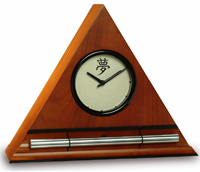 get the rest you need
Boulder, Colorado—an innovative company has taken one of life’s most unpleasant experiences (being startled awake by your alarm clock early Monday morning), and transformed it into something to actually look forward to. “The Zen Alarm Clock,” uses soothing acoustic chimes that awaken users gently and gradually, making waking up a real pleasure. Rather than an artificial recorded sound played through a speaker, the Zen Clock features an alloy chime bar similar to a wind chime. When the clock’s alarm is triggered, its chime produces a long-resonating, beautiful acoustic tone reminiscent of a temple gong. Then, as the ring tone gradually fades away, the clock remains silent until it automatically strikes again three minutes later. The frequency of the chime strikes gradually increase over ten-minutes, eventually striking every five seconds, so they are guaranteed to wake up even the heaviest sleeper. This gentle, ten-minute “progressive awakening” leaves users feeling less groggy, and even helps with dream recall.
By Sara Reistad-Long
O, The Oprah Magazine
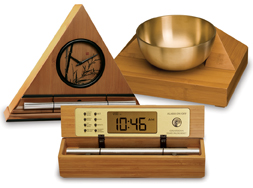 Now & Zen's Family of Alarm Clocks
Now & Zen’s Chime Alarm Clock Shop
1638 Pearl Street
Boulder, CO 80302
(800) 779-6383
Posted in Bamboo Chime Clocks, Chime Alarm Clocks, Natural Awakening, sleep, Sleep Habits
 What is a Walking Meditation Walking Meditation
What is it?
This component of numerous meditation traditions slows the walking process with the intention of bringing into awareness its most basic parts—lifting the foot, swinging it, placing it down—in order to bring a greater consciousness to daily life. When we break down the motion of walking, we realize how each action is a collection of sub-actions, and how the mind and body work together to create movement. “This is not walking for transportation, it’s walking as a tool for developing mindfulness in the present moment,” says John LeMunyon, L.M.T., co-owner of Heartwood Yoga in Birmingham, Ala., and a meditator for 30-plus years. You can practice walking meditation by itself, or combine it with one of the seated styles on the preceding pages. Used as an interlude, the walking technique is a good way to embody the insights gained during seated practice and to heighten their relevance in your daily life. Walking meditation shows clearly the Buddhist precept that “all action is preceded by intention,” says LeMunyon. “There’s always an intention; and when we are present to the moment, there is always a choice. It’s at the level of intention that we make our choices of how skillfully we want to live our lives.”
What’s it good for?
When you find yourself feeling restless or agitated, a physical practice like walking is a great way to quiet your mind and find grounding in your body. It can also help ease your transition from sitting meditation to the motion of “real life,” and vice versa.
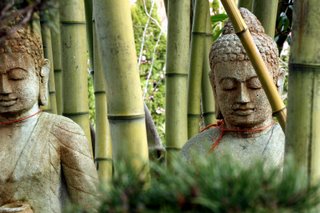 Walking Meditation How long does it take?
To begin, try walking for about 15 steps in two directions, about five minutes total. Or try interspersing this with five minutes of seated meditation.
How do I do it?
1. Find a private indoor or outdoor place with level ground and at least 20 feet of space to move.
2. Stand in a relaxed position with your feet parallel, shoulders loose, arms draped at your sides or clasped lightly in front of or behind you. Focus your eyes softly on the ground about 6 to 8 feet ahead (looking right at your feet can be distracting).
3. Breathe in as you lift your right heel. Pause and breathe out, leaving your toes resting on the ground.
4. Breathe in again as you slowly swing your right foot forward. Place the heel of your right foot on the ground as you exhale and roll the rest of the foot down, transferring your weight so it’s balanced between both feet. Pause for a full breath.
5. Repeat the entire sequence with your left foot, again matching each movement with an inhalation or exhalation, alternating for 15 steps. The goal is to keep your mind fully focused on your bodily sensations; it may help to think or softly say, “Lift, pause, swing, place, transfer, pause,” as you perform these movements.
6. When you’ve completed your paces in one direction, come to a stop with your feet parallel and pause for a few breaths. Then turn slowly, using the same movement pattern and matching each movement with an inhalation or exhalation. Pause again, facing the path you just walked. End by retracing your steps back to where you started.
adapted from naturalhealthmag.com By Frances Lefkowitz
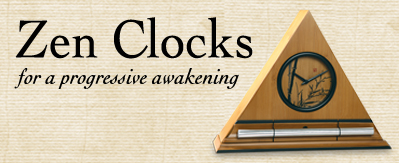 Zen Alarm Clocks and Meditation & Yoga Timers with Acoustic Sounds Now & Zen – The Chime Alarm Clock Store
1638 Pearl Street
Boulder, CO 80302
(800) 779-6383
Posted in Meditation Tools, Walking Meditation
|
|
|
|